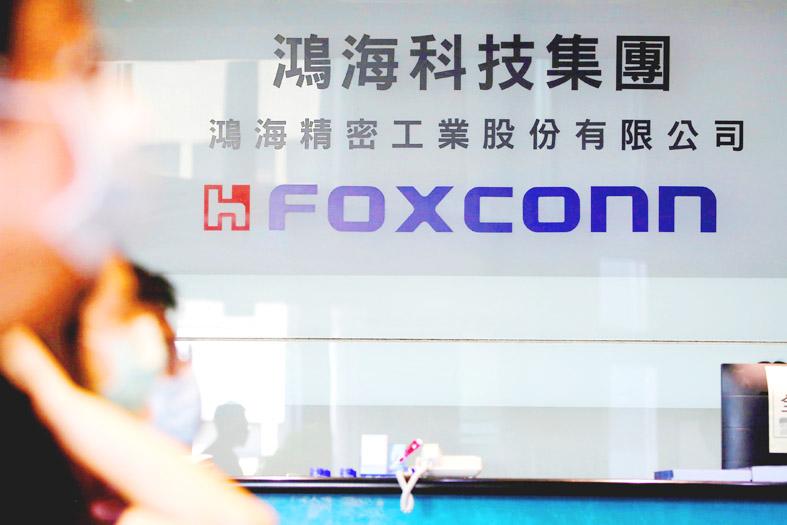Hon Hai Precision Industry Co (鴻海精密) reported third-quarter earnings of NT$36.98 billion (US$1.33 billion), up 24 percent quarter-on-quarter and 20 percent year-on-year, beating its own and analysts’ expectations, the company said yesterday.
Strong sales to their biggest customer, Apple Inc, which released its latest iPhone in the period, drove the gains.
Earnings per share rose to NT$2.67 last quarter, up from NT$2.23 in the third quarter of last year.

Photo: Ann Wang, Reuters
“The reason we were able to beat our expectations was the strong demand for our smart handset products, while cloud and personal computing sales were as expected,” Hon Hai chairman Young Liu (劉揚偉) told a virtual investors’ conference. “Sales of components and other products were slightly down due to the parts shortage crisis.”
The company expects the shortages to continue through the first half of next year, Liu said.
“I expect Hon Hai’s sales to grow by more than 15 percent quarter-on-quarter, because we are entering the busy season, but our growth is limited by the parts shortage,” he said. “On a year-on-year basis, I expect that fourth-quarter [revenue] would slide by 3 to 15 percent.”
In addition to production being limited by shortages, fourth-quarter sales last year were also unusually high due to COVID-19-related delays pushing sales into the following quarter.
Consumer electronics are expected to slide 15 percent year-on-year, while cloud products should remain flat compared with last year, he said.
However, cloud service-related products would “continue growth,” he said.
As for electric vehicles (EVs), Liu said he expects Hon Hai to develop production facilities in Mexico to accommodate additional production.
In the US, pickup truck models would be in production “as early as the third quarter of 2022,” he said.
In the second half of next year, Hon Hai would begin its Middle East EV project, while it has plans to establish production lines in Europe and India through “lean investments,” Liu said.
“In the first half of 2022, we will start selling the E-bus in Taiwan, and work with e-scooter company Gogoro on battery module and battery swap station production,” he said.
“In Mexico, we will expand our current automotive production facilities,” he said. “In the second half of 2022, our collaboration with Lordstown Motors should yield fruit with its Endurance pickup truck that can start contributing to revenue as soon as the third quarter.”
Hon Hai’s auto component business has so far this year generated revenue of more than NT$10 billion, Liu said, adding that he expects further growth next year.
Hon Hai’s goal to lift gross margin to 10 percent by 2025 remains unchanged, he said.

The US dollar was trading at NT$29.7 at 10am today on the Taipei Foreign Exchange, as the New Taiwan dollar gained NT$1.364 from the previous close last week. The NT dollar continued to rise today, after surging 3.07 percent on Friday. After opening at NT$30.91, the NT dollar gained more than NT$1 in just 15 minutes, briefly passing the NT$30 mark. Before the US Department of the Treasury's semi-annual currency report came out, expectations that the NT dollar would keep rising were already building. The NT dollar on Friday closed at NT$31.064, up by NT$0.953 — a 3.07 percent single-day gain. Today,

‘SHORT TERM’: The local currency would likely remain strong in the near term, driven by anticipated US trade pressure, capital inflows and expectations of a US Fed rate cut The US dollar is expected to fall below NT$30 in the near term, as traders anticipate increased pressure from Washington for Taiwan to allow the New Taiwan dollar to appreciate, Cathay United Bank (國泰世華銀行) chief economist Lin Chi-chao (林啟超) said. Following a sharp drop in the greenback against the NT dollar on Friday, Lin told the Central News Agency that the local currency is likely to remain strong in the short term, driven in part by market psychology surrounding anticipated US policy pressure. On Friday, the US dollar fell NT$0.953, or 3.07 percent, closing at NT$31.064 — its lowest level since Jan.

Hong Kong authorities ramped up sales of the local dollar as the greenback’s slide threatened the foreign-exchange peg. The Hong Kong Monetary Authority (HKMA) sold a record HK$60.5 billion (US$7.8 billion) of the city’s currency, according to an alert sent on its Bloomberg page yesterday in Asia, after it tested the upper end of its trading band. That added to the HK$56.1 billion of sales versus the greenback since Friday. The rapid intervention signals efforts from the city’s authorities to limit the local currency’s moves within its HK$7.75 to HK$7.85 per US dollar trading band. Heavy sales of the local dollar by

The Financial Supervisory Commission (FSC) yesterday met with some of the nation’s largest insurance companies as a skyrocketing New Taiwan dollar piles pressure on their hundreds of billions of dollars in US bond investments. The commission has asked some life insurance firms, among the biggest Asian holders of US debt, to discuss how the rapidly strengthening NT dollar has impacted their operations, people familiar with the matter said. The meeting took place as the NT dollar jumped as much as 5 percent yesterday, its biggest intraday gain in more than three decades. The local currency surged as exporters rushed to